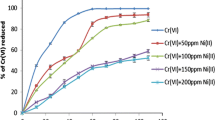Abstract
Hexavalent chromium reduction and accumulation by Acinetobacter AB1 isolated from Fez tanneries effluents were tested. The effects of some environmental factors such as pH, temperature, and exposure time on Cr(VI) reduction and resistance were investigated. We found that this strain was able to resist to concentrations as high as 400 mg/l of Cr(VI). Moreover, pH 10 and the temperature 30°C constitute favourable conditions to the growth and reduction of Acinetobacter AB1. Complete reduction of Cr(VI) was observed at low initial Cr(VI) concentrations of 50 mg/l after 72 h of incubation. Furthermore, Transmission electron microscope (TEM) analysis showed morphological changes in AB1 strain due 48H exposure to 100 mg/l chromate concentration and revealed circular electron dense (dark black point) inclusion within the cell cytoplasm suggesting chromium deposition within the cells.







Similar content being viewed by others
References
PREM (2004) Projet Pérennité des Ressources en Eau du Maroc Rapport Final Janvier Royaume du Maroc Secrétariat d’Etat Chargé de l’Environnement Projet financé par l’USAID/Maroc
Anita I, Kalpana M, Bhavanath J (2004) Accumulation of hexavalent chromium by an exopolysaccharide producing marine Enterobacter cloaceae. Mar Pollut Bull 49:974–977
Amoozegar MA, Ghasemi A, Razavi MR, Naddaf S (2007) Evaluation of hexavalent chromium reduction by chromate-resistant moderately halophile, Nesterenkonia sp. strain MF2. Process Biochem 42:1475–1479
McLean J, Beveridge TJ (2001) Chromate reduction by a pseudomonad isolated from a site contaminated with chromate copper arsenate. Appl Environ Microbiol 67:1076–1084
Pino GH, Mesquita LMS, Torem ML, Pinto GAS (2006) Biosorption of cadmium by green coconut shell powder. Miner Eng 19:380–387
Park JM, Park D, Yun Y (2005) Use of dead fungal biomass for the detoxification of hexavalent chromium: screening and kinetics. Process Biochem 40(7):2559–2565
Zahoor A, Rehman A (2009) Isolation of Cr(VI) reducing bacteria from industrial effluents and their potential use in bioremediation of chromium containing wastewater. J Environ Sci 21(6):814–820
Srivastava S, Thakur IS (2006) Evaluation of bioremediation and detoxification potentiality of Aspergillus niger for removal of hexavalent chromium in soil microcosm. Soil Biol Biochem 38:1904–1911
Ma Z, Zhu W, Long H, Chai L, Wang Q (2007) Chromate reduction by resting cells of Achromobacter sp. Ch-1 under aerobic conditions. Process Biochem 42:1028–1032
Zakaria ZA, Zakaria Z, Surif S, Ahmad WA (2006) Bioremediation of Cr(VI)-containing electroplating wastewater using Acinetobacter sp. International Conference on Environment (ICENV 2006), Penang, 13–15 November 2006
Zakaria ZA, Zakaria Z, Surif S, Ahmad WA (2007) Hexavalent chromium reduction by Acinetobacter haemolyticus isolated from heavy-metal contaminated wastewater. J Hazard Mater 146:30–38
Lane DJ (1991) 16S/23S rRNA sequencing. In: Stackebrandt E; Goodfellow M (eds) Nucleic acid techniques in bacterial systematics, Wiley, Chichester, pp 115–175
Jeanmougin F, Thompson JD, Gouy M, Higgins DG, Gibson TJ (1998) Multiple sequence alignment with clustal X trends. Biochem Sci 23:403–405
Holder M, Lewis PO (2003) Phylogeny estimation: traditional and Bayesian approaches. Nat Rev Genet 4:275–284
Page RDM (1996) T-REEVIEW: an application to display of phylogenetic trees on personal computers. Comput Appl Biosci 12:357–358
Apha (1995) Standard methods for the examination of water and wastewater, 19th edn. American Public Health Association, Washington, DC
CEAEQ (Centre d’expertise en analyse environnementale du Québec) (2008) Détermination du chrome hexavalent: méthode colorimétrique, MA. 200—CrHex 1.1, 2 July 2008
Bihari Z, Pettkó-Szandtner A, Csanádi G, Balázs M, Bartos P, Kesseru P, Kiss I, Mécs I (2007) Isolation and characterization of a novel n-alkane-degrading strain Acinetobacter haemolyticus AR-46. J Biosci 62(3–4):285–295
Sarangi A, Krishnan C (2008) Comparison of in vitro Cr(VI) reduction by CFEs of chromate resistant bacteria isolated from chromate contaminated soil. Bioresour Technol 99(10):4130–4137
Wang PC, Mori T, Toda K, Ohtake H (1990) Membrane-associated chromate reductase activity from Enterobacter cloacae. J Bacteriol 172:1670–1672
Nragu JO, Nieboer E (1988) Chromium in the natural and human environments. Wiley, New York
He Z, Gao F, Sha T, Hu Y, He C (2009) Isolation and characterization of a Cr(VI)-reduction Ochrobactrum sp. strain CSCr-3 from chromium landfill. J Hazard Mater 163(2–3):869–873
Wani R, Kodam KM, Gawai KR, Dhakephalkar PK (2007) Chromate reduction by Burkholderia cepacia MCMB-821, isolated from the pristine habitat of alkaline Crater Lake. Appl Microbiol Cell Physiol 75:627–632
Yakup AM, Gulay B, Meltem Y, Sema B, Omer G (2004) Biosorption of Hg2+, Cd2+, and Zn2+ by Ca—alginate and immobilized wood-rotting fungus Funalia trogii. J Hazard Mater B 109(1–3):191–199
Farrell SO, Ranallo RT (2000) Experiments in biochemistry. A hands-on approach. Saunders College Publication, Orlando
Middleton SS, Latmani RB, Mackey MR, Ellisman MH, Tebo BM, Criddle CS (2003) Cometabolism of Cr(VI) by Shewanella oneidensis MR-1 produces cell-associated reduced chromium and inhibits growth. Biotechnol Bioeng 83:627–637
Ohtake H, Cervantes C, Silver S (1987) Decreased chromate uptake in Pseudomonas fluorescens carrying a Cr(VI) resistance plasmid. J Bacteriol 169:3853–3856
Mabbett AN, Macaskie LE (2001) A novel isolate of Desulfovibrio sp. With enhanced ability to reduce Cr(VI). Biotechnol Lett 23:683–687
Gadd GM (1988) Accumulation of metal by microorganisms and algae. In: Rehm H (ed) Biotechnology: a comprehensive complete treatise, vol 6B, special microbial process, vol 4. Verlagsgesellschaft, Weinheim, pp 401–403
Brierley CL (1990) Bioremediation of metal-contaminated surface and groundwater. Geomicrobiol J 8(3–4):201–223
Srivastava S, Thakur IS (2007) Evaluation of biosorption potency of Acinetobacter sp. For removal of hexavalent chromium from tannery effluent. Biodegradation 18:637–646
Acknowledgments
This study is supported by Programa de Cooperación Interuniversitaria e Investigación Científica entre España y Marruecos, y proyecto A/5712/06 Estudio de la biodiversidad bacteriana presente en el río Sebou mediante el uso de técnicas microbiologías clásicas y moleculares (DGGE Y FISH).
Author information
Authors and Affiliations
Corresponding author
Electronic Supplementary Material
Rights and permissions
About this article
Cite this article
Essahale, A., Malki, M., Marín, I. et al. Hexavalent Chromium Reduction and Accumulation by Acinetobacter AB1 Isolated from Fez Tanneries in Morocco. Indian J Microbiol 52, 48–53 (2012). https://doi.org/10.1007/s12088-011-0187-1
Received:
Accepted:
Published:
Issue Date:
DOI: https://doi.org/10.1007/s12088-011-0187-1





